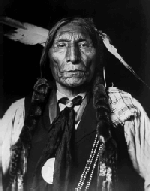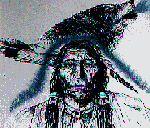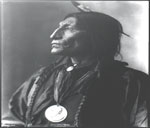

The Cheyenne were divided into two groups, the Southern Cheyenne who were located along the upper Arkansas River and the Northern Cheyenne who were located at the headwaters of the Platt River.
In 1864 a group of peaceful Cheyenne were massacred by U.S. Military forces at Sand Creek, Colorado. In 1876 the Cheyenne joined the Sioux and defeated Col. George Custer at the Battle of the Little Bighorn. In 1877 the Cheyenne surrendered and were relocated to "Indian Territory: which is present day Oklahoma.
In 1990 the total number of Cheyenne
descendants was about 11,000 many of whom still live on
reservations in
southwestern Oklahoma and southeastern Montana.
During the late 1870s he was forced to leave the open plains
and
relocate his tribe on to the Cheyenne and Arapaho Indian
Reservation in
Indian Territory. He was awarded the Benjamin Harrison Peace
Medal in
1890 for his assistance in the Cherokee Commission.
F. A. Rinehart photographed the chief in 1898, Lancy DeGill
photographed him in 1909.[4] The iconic portrait photographs
of Wolf
Robe have been popular throughout the last century. Numerous
painters
and sculptors have, in turn, created artworks based upon these
photographs. Although it is unlikely, some people believe his
was the
model for the Indian Head nickel.
Additional information from Ken West,
artist:


by Terry
Hartman
- Yaqui | by Frank
A.
Rinehart
![]() Return to
Indigenous Peoples' Literature
Return to
Indigenous Peoples' Literature
Compiled by: Glenn Welker
This site has been accessed over 10,000,000 times since
February 8,
1996.